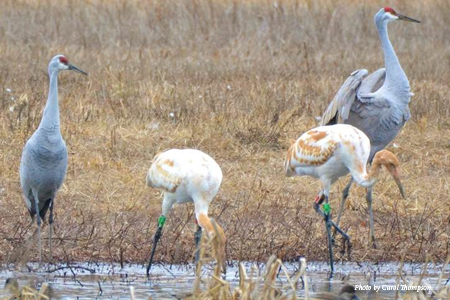Media Contact: Sara Gavney Moore, 608.356.9462 ext. 155
The chick, released this year as part of a species bolstering effort, is now safe at a refuge in Alabama

Baraboo, Wis. (Dec. 27, 2016) – A missed flight around the holidays can be frustrating, but for Whooping Cranes, it’s potentially fatal. That is no longer the case for a young Whooping Crane that missed his annual migration, thanks to experts from The International Crane Foundation (ICF), a nonprofit organization working on behalf of Whooping Cranes in North America. ICF experts noticed the fledgling, “70-16,” did not head south with his fellow cranes and made the effort to personally escort him 781 miles to warmer weather at the Wheeler National Wildlife Refuge in Alabama. As of today, only 450 of the rare birds exist in the wild across North America, so each individual is critical for species survival and genetic diversity.
70-16, affectionately called “Bryce” (after the national park), hatched at the ICF facility in Baraboo, Wis. and was raised by two Whooping Cranes on-site as part of a breeding program. He was released nearby in mid-November, with the hopes that he would assimilate with flocks in the area and eventually follow them south for their annual migration. When Bryce remained behind, ICF knew they needed to act.
“While the cold was an issue, we were more concerned that a lack of access to roosting water would put Bryce at a higher risk of predation,” said Anne Lacy, ICF Crane Research Coordinator. “Our team was able to quickly and safely secure him before evaluating his health and driving him south for the winter.”
Bryce made the 11 hour trip comfortably and was evaluated one more time on Wednesday, Dec. 14, before being released into the refuge – a common wintering ground for both Whooping Cranes and Sandhill Cranes. ICF staff remained on grounds for 24 hours to ensure the crane adapted well to the relocation. Bryce was soon seen in the company of 69-16, another Whooping Crane released by ICF this year that successfully made her migration earlier this month. Partners at the Wheeler National Wildlife Refuge will continue to monitor Bryce and the other cranes for the rest of the season.
This happened once before with another newly-released Whooping Crane chick in 2013, also known as 59-13 or “Latka.” ICF experts had to step in and manually relocate the bird, which had not left Wisconsin for migration. This bird has since paired with another Whooping Crane and has made successful migrations ever since. It is expected that Bryce will socialize with his fellow cranes over the winter and follow the birds up north in the summer.
“While we still aren’t sure exactly what drives some young cranes to migrate while other individuals, like Bryce, might remain behind, we are happy to have the wealth of experience on staff to handle situations like these when they arise,” added Lacy.
ICF’s Whooping Crane efforts are part of a collaborative management and monitoring program operated by the Whooping Crane Eastern Partnership whose members include the International Crane Foundation, U.S. Fish and Wildlife Service, Patuxent Wildlife Research Center, Operation Migration, Wisconsin Department of Natural Resources, and other associated partners.
Whooping Cranes are one of the rarest birds in North America. Unregulated hunting and habitat loss forced Whooping Cranes to the brink of extinction. Through painstaking efforts by ICF and others, they are making a slow, yet steady comeback from a low of only 21 individuals in the wild in 1944. Whooping Crane recovery is a symbol of hope for all endangered species.
###
About the International Crane Foundation
The International Crane Foundation plays a leading role in the conservation of Whooping Cranes, from managed breeding and release programs to habitat protection, citizen education and engagement, and threat reduction along their flyways. Learn more about the International Crane Foundation and its work to protect Endangered Whooping Cranes at www.savingcranes.org.
About the Whooping Crane Eastern Partnership
The Whooping Crane Eastern Partnership is a group of agencies, non-profit organizations and individuals, formed to restore to eastern North America, a migratory population of Whooping Cranes. More information about the partnership is available at www.bringbackthecranes.org.
